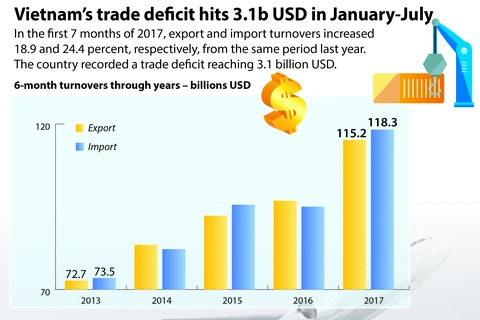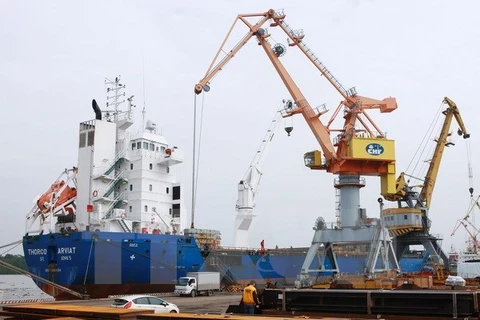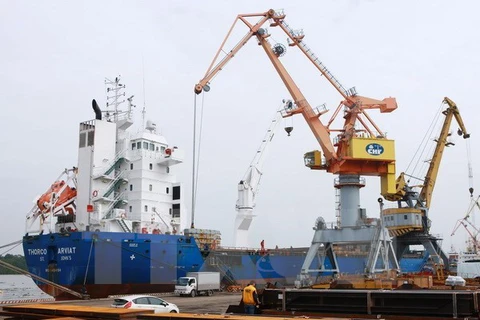Hanoi (VNA) - Promoting regional linkage from production to distribution is essential to turn the country’s southern part into a trade hub.
Efforts have been made to establish regional linkage in recent years but there were bottlenecks to be removed to create breakthroughs, especially in developing a supply chain and logistics.
For example, in the agricultural sector, as local products were of inconsistent quality coupled with a shortage of established brands and planning, farmers were still faced with the pressure of selling their products at low prices from intermediaries and traders.
According to Le Minh Duc, director of the Long An provincial Department of Industry and Trade, many products were still struggling to find stable markets.
This was because of a lack of coordination between producers and distributors.
Major retailers such as Saigon Co.op, Lotte Mart, Aeon Vietnam and Big C promised to give priority to Vietnamese products on their shelves but they also had strict quality control requirements, experts said.
It was important to improve product quality and promote the regional linkage from production to distribution.
In addition, reducing intermediaries to cut product prices to end-users and improve competitiveness was also an important measure.
The southern provinces and cities were hastening efforts towards trade promotion to expand markets while developing trade infrastructure system, including supermarkets and wholesale markets to ensure a convenient circulation of goods.
Nguyen Minh Toai, director of the Can Tho municipal Department of Industry and Trade, said that provinces and cities should raise solutions to support farmers to join in the production chain and develop a plan that focuses on products of strength.
In addition, provinces and cities in the region should join each other to share market information to ensure production to meet the market demand and prevent speculation or trade frauds.
According to Vu Kim Hanh, chairwoman of the Vietnamese High-Quality Product Business Association, a quality control system must be set up to ensure quality from raw material, processing to consumption.
The southern region includes 20 provinces and cities, accounting for 60 percent of the country’s industrial production and 57 percent of goods and services value.
The region planned to reach a total retail sale of goods and services of nearly 2 quadrillion VND (8.8 billion USD) this year, or a rise of 11.5 percent over 2016, and an export revenue of 105 billion USD (up by 11.6 percent).-VNA
Efforts have been made to establish regional linkage in recent years but there were bottlenecks to be removed to create breakthroughs, especially in developing a supply chain and logistics.
For example, in the agricultural sector, as local products were of inconsistent quality coupled with a shortage of established brands and planning, farmers were still faced with the pressure of selling their products at low prices from intermediaries and traders.
According to Le Minh Duc, director of the Long An provincial Department of Industry and Trade, many products were still struggling to find stable markets.
This was because of a lack of coordination between producers and distributors.
Major retailers such as Saigon Co.op, Lotte Mart, Aeon Vietnam and Big C promised to give priority to Vietnamese products on their shelves but they also had strict quality control requirements, experts said.
It was important to improve product quality and promote the regional linkage from production to distribution.
In addition, reducing intermediaries to cut product prices to end-users and improve competitiveness was also an important measure.
The southern provinces and cities were hastening efforts towards trade promotion to expand markets while developing trade infrastructure system, including supermarkets and wholesale markets to ensure a convenient circulation of goods.
Nguyen Minh Toai, director of the Can Tho municipal Department of Industry and Trade, said that provinces and cities should raise solutions to support farmers to join in the production chain and develop a plan that focuses on products of strength.
In addition, provinces and cities in the region should join each other to share market information to ensure production to meet the market demand and prevent speculation or trade frauds.
According to Vu Kim Hanh, chairwoman of the Vietnamese High-Quality Product Business Association, a quality control system must be set up to ensure quality from raw material, processing to consumption.
The southern region includes 20 provinces and cities, accounting for 60 percent of the country’s industrial production and 57 percent of goods and services value.
The region planned to reach a total retail sale of goods and services of nearly 2 quadrillion VND (8.8 billion USD) this year, or a rise of 11.5 percent over 2016, and an export revenue of 105 billion USD (up by 11.6 percent).-VNA
VNA

























